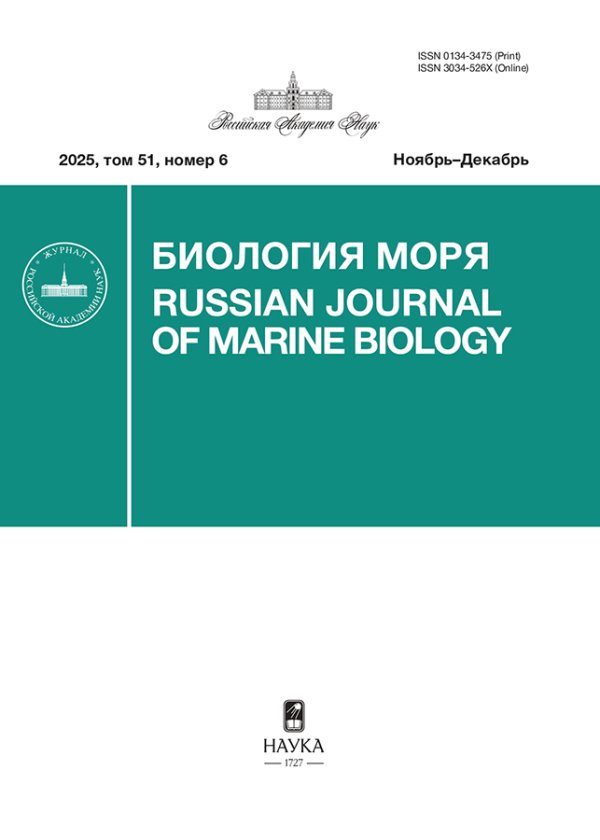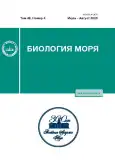Vol 49, No 4 (2023)
- Year: 2023
- Published: 01.07.2023
- Articles: 8
- URL: https://journals.rcsi.science/0134-3475/issue/view/7694
Full Issue
ОБЗОР
Marine Labyrinthulomycetes
Abstract
Labyrinthulomycetes are a small but very important group of marine fungi-like organisms. Labyrinthulomycetes are ubiquitous, can be associated with living plants, algae, and animals and can decompose a variety of organic remains. These organisms are able to synthesize and abundantly accumulate lipids, in particular, polyunsaturated fatty acids, some of which are of great interest for biotechnology. The scientific information about labyrinthulomycetes is currently accumulating very quickly. Our study is devoted to reviewing presently available data on the structure, biology and taxonomy of these organisms. The review examines the problems of methodological approaches to the study of these organisms, as well as the diversity, distribution and significance of Labyrinthulomycetes in marine ecosystems.
 219-229
219-229


ОРИГИНАЛЬНЫЕ СТАТЬИ
Composition of Leukocytes of the Peripheral Blood of Plunderfish Pogonophryne sp. (Perciformes: Artedidraconidae) and Grey Rockcod Lepidonotothen squamifrons (Günther, 1880) (Perciformes: Nototheniidae) from the Ross Sea
Abstract
A comparative study of the composition of peripheral blood leukocytes of plunderfish and grey rockcod or squama caught in the Ross Sea has been carried out. Blood smears revealed cells of different morphofunctional characteristics and structure: lymphocytes, monocytes, neutro- and eosinophils, and blast cells. An analysis of the leukogram showed that the white blood of the studied species has a lymphoid character. In the rockcod leukogram, the proportion of lymphocytes is significantly higher, while that of monocytes and blast forms is lower. In the plunderfish, in comparison with grey rockcod, the leukocyte cells of the same name are usually larger.
 230-235
230-235


Assessment of Microplastic Degradation in Bottom Sediments Using Raman Microspectroscopy and Atomic Force Microscopy
Abstract
The assessed degradation of microplastics from bottom sediments of the Laptev Sea, the Weddell Sea, the Chukchi Sea and Peter the Great Bay, Sea of Japan, was studied using Raman microspectroscopy and atomic force microscopy (AFM). The degree of amorphous-crystallinity of polyethylene terephthalate (PET) was determined by the ratio of Raman mode intensities (I1095 cm–1 / I1115 cm–1). Changes in the topography and mechanical properties of the surface of polymer fragments were studied by AFM methods. It has been shown that the degradation of PET found in the bottom sediments of the Laptev Sea affects mainly its crystalline phase. The amorphous phase of PET is affected to a much lesser extent or not at all. The same changes in the phase composition of the PET surface have been shown after plastic exposure in a marine aquarium in silty sand from the Amur Bay (Peter the Great Bay, Sea of Japan). AFM data show an increase in PET surface roughness and a decrease in elasticу modulus (Young’s modulus) in bottom sediment samples. Raman microspectroscopy also shows signs of degradation of cellophane fragments from the Weddell Sea, polyvinyl chloride (PVC) from the Laptev Sea, and polyethylene (PE) from the Amur Bay.
 236-244
236-244


Frequency of Occurrence of the North Pacific Minke Whale Balaenoptera acutorostrata scammoni Deméré, 1986 off the North-Eastern Coast of Sakhalin Island in 2008–2021
Abstract
The seasonal and interannual variability in the frequency of occurrence of the North Pacific common minke whale (Minke whale) Balaenoptera acutorostrata scammoni Deméré, 1986 off the north-eastern coast of Sakhalin Island (the Sea of Okhotsk) in 2008–2021 was studied. It has been shown that the occurrence of whales of this species in the study area has significant seasonal and interannual variability. The average frequency of occurrence in even years of observations was 1.6 times higher than in odd years and amounted to 7.1 and 4.4%, respectively. It has been suggested that the frequency of occurrence of minke whale in the study area is determined by the intensity of coastal wind upwelling off the eastern coast of Sakhalin Island.
 245-252
245-252


Blood Cell Morphology of the Beluga Whale Delphinapterus leucas (Pallas, 1776)
Abstract
Clinical blood analysis, combined with cytomorphological examination is an important diagnostic tool for assessing the physiological state of animals. The cytomorphological features of blood cells have been described for terrestrial mammals, and well-illustrated veterinary atlases have been created, in which normal and pathological forms of animal blood cells are displayed. However, such information is virtually non-existent for marine mammals. In this article, we present the results of a study of the morphology of the blood cells of the beluga (also known as white) whale Delphinapterus leucas, obtained by supravital staining of blood smear preparations with brilliant cresyl blue, methylene blue, and utilizing the standard Romanowsky–Giemsa staining technique. We describe the main types of blood cells of marine mammals: erythrocytes, segmented neutrophils, eosinophils, monocytes, lymphocytes, band neutrophils, as well as rare basophils.
 253-260
253-260


The Summer Distribution of Sculpin Fish (Cottidae) on the Continental Margin of the Sea of Japan from Cape Povorotny to Cape Mapatsa
Abstract
We identified Gymnocanthus detrisus as the absolute dominant species in the taxocene of sculpins (family Cottidae), caught below 20 m water depth in the aquatic area between Cape Povorotny and Cape Mapatsa. Myoxocephalus polyacanthocephalus, Gymnocanthus herzensteini, Enophrys diceraus and Triglops pingelii are dominant as well. Subdominant species are Triglops septicus, Icelus cataphractus, Hemilepidotus gilberti, Myoxocephalus brandtii, Myoxocephalus jaok, Taurocottus bergii and Gymnocanthus pistilliger. Other types of fishes identified in this area are insignificant in abundance. Sculpins aggregate at greater depth in the southern aquatic areas, from Cape Povorotny to Olga Bay, and from Olga Bay to Cape Belkin, than in the northern areas, between Cape Belkin and Cape Zolotoy, particularly between Cape Zolotoi and Cape Mapatsa. We attribute this phenomenon to the differences in water regimes. The highest densities of sculpins are generally typical for the southern area. Conversely the lowest densities are typical in the northern area. However, some species prefer northern areas. The minimum depths habitat for different species varying from less than 20 m to 82 m; the maximum depths range from 80 to 530 m. Due to the high species diversity, aggregations of sculpins are observed in a wide bathymetric range from 20 to 300 m, with peak values at depths of 150–200 m. Sculpins live in summer at water temperatures above 0.4°C. The shallow water species of sculpins tolerate much greater temperature ranges then deep water species. Hence, the stenotherm increases in deep water species.
 261-274
261-274


КРАТКИЕ СООБЩЕНИЯ
Influence of Zinc and Iron on Population Growth and Physiological State of Microalgae Heterosigma akashiwo (Raphidophyceae)
Abstract
It was studied the influence of zinc and iron at concentrations of 50 and 100 µg/L on cell number, chlorophyll a fluorescence, content of photosynthetic pigments and reactive oxygen species, as well as neutral lipids in the raphidophyte algae Heterosigma akashiwo. Zinc has been found to act on physiological and biochemical processes without affecting the population dynamics of microalgae. It was revealed the negative effect of iron on the fluorescence of chlorophyll a, number of photosynthetic pigments, reactive oxygen species and neutral lipids. The most toxic metal for H. akashiwo turned out to be iron. It was shown that the concentrations of the studied metals do not contribute to the development of H. akashiwo “blooms”.
 275-280
275-280


The Fatty Acid Composition of a Deep-Sea Acorn Worm Quatuoralisia malakhovi Ezhova et Lukinykh, 2022 (Hemichordata: Enteropneusta)
Abstract
This study investigates the fatty acid (FA) composition of total lipids in Quatuoralisia malakhovi Ezhova et Lukinykh, 2022 (Hemichordata: Enteropneusta), a new species of deep-sea acorn worm that was collected on the slope of the Piip Volcano in the Bering Sea. The data obtained indicate that the main components of lipids in Q. malakhovi are fatty acids of bacterial and diatom origin. The food source of the studied species is detritus containing large amounts of not only bacteria, but also diatoms. The results could be used in trophic studies of communities that include Enteropneusta.
 281-284
281-284












